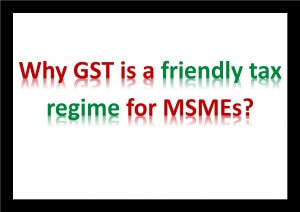An attractive feature of the GST regime is that it gives concessional and easy procedures for small businesses. There are several features that makes the GST small business friendly. With greater fine-tuning of the GST regime, the GST Council added several clauses that facilitates small businesses. Following are the important provisions in the GST that gives concessional treatment to MSMEs.
- Exemption for small businesses from GST registration
Taxpayers with an aggregate turnover of Rs 40 lakh would now be exempted from the GST. For the north eastern states, the exemption would now be Rs 20 lakh. Previously, the turnover limit was Rs 20 lakh and Rs 10 lakh respectively for the general states and north eastern states. The decision was made at the 32nd meeting of the GST Council.
The new higher limit is applicable only for goods providers. For service providers, the limit continues to be Rs20 lakh for all states except for special states where it is Rs10 lakh. Similarly, the new limit will not be applicable for selling goods inter-state, i.e., from one state to another.
Tax analysts assess that that annual revenue loss on account of doubling exemption limit to Rs 40 lakh, when all states implement it, will be around Rs 5,200 crore.
|
How the GST is promoting small businesses?
|
The higher (exemption) limit (of Rs 40 lakh) is applicable for those businesses who deal in goods and also do intra-state trade and not for those who do inter-state transactions.
States can continue to retain the previous limit of Rs 20 lakh if they feel that higher exemption limit of Rs 40 lakh is causing base erosion (tax loss from low number of taxpayers).
Since a very large part of GST comes from formal sector and large companies, the increased exemption limit will give more comfort to the taxpayers than producing revenue loss effect for the government.
- Hassle free return filing system for small taxpayers
The GST filing system has been made convenient for the small taxpayers. Small taxpayers with a turnover of upto Rs 5 crores have to file returns quarterly rather than the monthly filing. Sahaj (B2C), Sugam (B2B and B2C and normal quarterly filings are reducing the workload of small businesses.
- The Composition Scheme: exemption for small taxpayers
Under the composition scheme, there is a low tax rate for small businesses both goods and services. The beneficiaries are identified in terms of turnover. Under this scheme, low turnover firms can opt for a concessional tax rate if their turnover is below the set limit. Similarly, there is low compliance procedures or compliance costs for small business.
Composition scheme: concessional rate and procedures for low turnover firms
As per the latest regulation (effective from April 1, 2019), small businesses with a higher turnover limit of up to Rs 1.5 crore can pay just 1% tax and will have fewer procedural formalities.
The 1 per cent tax became and the 1.5 crore limit became effective from April 1, 2019 for manufacturers and traders and restaurant services. The previous limit was Rs 1 crore. The composition scheme limit remains at Rs 75 lakhs for N.E states & Uttarakhand.
|
Composition scheme from April 1, 2019 |
||
Turnover limit |
Applicable sector/entities |
Applicable tax rate |
| Rs 1.5 crore | Manufactures and traders (goods). | 1% |
| Rs 1.5 crore | Restaurants (not serving alcohol). | 5% |
|
Rs 50 lakh |
Service providers and both goods and services providing firms. | 6% |
Composition scheme for service providers
Initially, there was no composition scheme for service providers except restaurants. Now, it has been extended to them as well. Here, for the service providers and suppliers of both goods and services up to a turnover of Rs 50 lakh, they are eligible to opt for the GST composition scheme by paying a tax of 6 per cent. Service providers otherwise have to give higher rates of 12 and 18 per cent for most services under GST.
In the case of services, businesses with inter-State supplies, manufacturers of ice cream, pan masala and tobacco, and e-commerce players cannot opt for the composition scheme.
Advantage of composition scheme is that while a regular GST taxpayer has to pay taxes on a monthly basis, a composition supplier is required to pay taxes on a quarterly basis.
The Composition scheme was initially applicable only for goods providers but later the GST Council in its January 2019 meeting permitted service providers and those dealing in both goods and services with a turnover of up to Rs 50 lakh to opt for composition scheme with effect from April 1, 2019.
The GST composition scheme give big relief to the MSMEs. As per the GSTN data there are around 1.23 crore registered taxpayers as on October 2019. Of these, over18 lakh taxpayers or around 15% have opted for composition scheme.
The GSTN has provided a Free Accounting and Billing Software to Small Taxpayers.
These are some of the leading measures that support the MSME sector. Several others like automatic refunding of input tax credit for exporters, simplifying the input tax credit system etc. adds to the benefit of the small taxpayers under the GST.
*********










